canada-economy加拿大概况(英语)
- 格式:ppt
- 大小:1.27 MB
- 文档页数:11
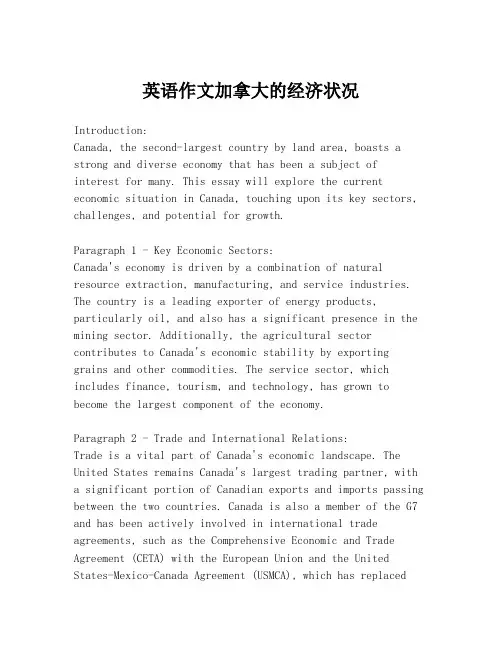
英语作文加拿大的经济状况Introduction:Canada, the second-largest country by land area, boasts a strong and diverse economy that has been a subject ofinterest for many. This essay will explore the current economic situation in Canada, touching upon its key sectors, challenges, and potential for growth.Paragraph 1 - Key Economic Sectors:Canada's economy is driven by a combination of natural resource extraction, manufacturing, and service industries. The country is a leading exporter of energy products, particularly oil, and also has a significant presence in the mining sector. Additionally, the agricultural sector contributes to Canada's economic stability by exporting grains and other commodities. The service sector, which includes finance, tourism, and technology, has grown to become the largest component of the economy.Paragraph 2 - Trade and International Relations:Trade is a vital part of Canada's economic landscape. The United States remains Canada's largest trading partner, with a significant portion of Canadian exports and imports passing between the two countries. Canada is also a member of the G7 and has been actively involved in international trade agreements, such as the Comprehensive Economic and Trade Agreement (CETA) with the European Union and the United States-Mexico-Canada Agreement (USMCA), which has replacedNAFTA.Paragraph 3 - Challenges and Economic Fluctuations:Like any other economy, Canada faces challenges that can impact its economic stability. Fluctuations in global commodity prices can significantly affect the country'sexport revenues. Additionally, the economy is sensitive to changes in the business cycle of its largest trading partner, the United States. The Canadian government has been implementing various fiscal and monetary policies to mitigate these risks and maintain economic growth.Paragraph 4 - Innovation and Future Prospects:Canada has been investing in innovation and technology to diversify its economy and reduce reliance on natural resources. The government supports research and developmentin sectors such as artificial intelligence, biotechnology,and clean energy. These efforts are expected to create newjob opportunities and contribute to long-term economic growth.Conclusion:In conclusion, Canada's economy is robust and well-diversified, with a strong foundation in natural resourcesand a growing emphasis on innovation and technology. While challenges such as global market volatility and trade uncertainties persist, the country's strategic international relations and commitment to economic diversification position it well for future growth and stability.。
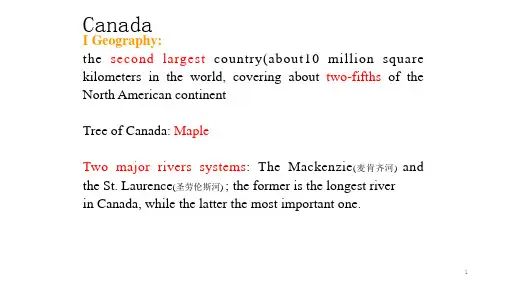
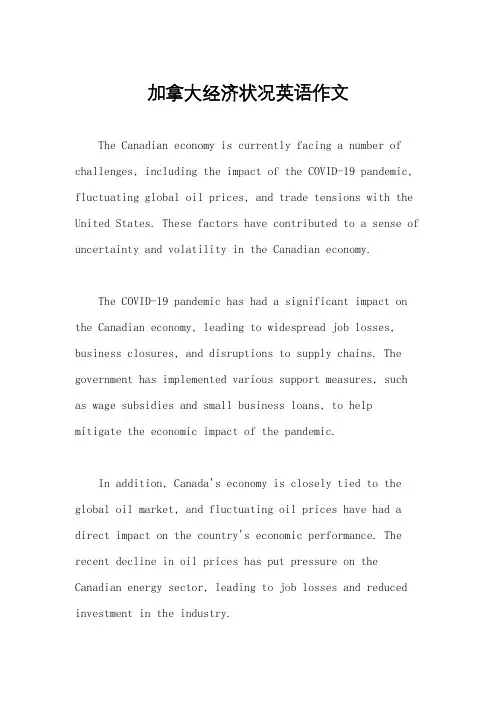
加拿大经济状况英语作文The Canadian economy is currently facing a number of challenges, including the impact of the COVID-19 pandemic, fluctuating global oil prices, and trade tensions with the United States. These factors have contributed to a sense of uncertainty and volatility in the Canadian economy.The COVID-19 pandemic has had a significant impact on the Canadian economy, leading to widespread job losses, business closures, and disruptions to supply chains. The government has implemented various support measures, such as wage subsidies and small business loans, to helpmitigate the economic impact of the pandemic.In addition, Canada's economy is closely tied to the global oil market, and fluctuating oil prices have had a direct impact on the country's economic performance. The recent decline in oil prices has put pressure on the Canadian energy sector, leading to job losses and reduced investment in the industry.Furthermore, trade tensions with the United States have added another layer of uncertainty to the Canadian economy. The renegotiation of the North American Free Trade Agreement (NAFTA) and the imposition of tariffs on Canadian steel and aluminum have created challenges for Canadian businesses and exporters.Despite these challenges, there are also signs of resilience and innovation in the Canadian economy. Many businesses have adapted to the new economic realities by embracing digital technologies and finding new ways to reach customers. The government has also announced plans to invest in infrastructure and green technologies to stimulate economic growth and create jobs.In conclusion, the Canadian economy is currently navigating through a period of uncertainty and volatility, with the impact of the COVID-19 pandemic, fluctuating oil prices, and trade tensions with the United States posing significant challenges. However, there are also signs ofresilience and innovation as businesses and the government adapt to the new economic realities.。
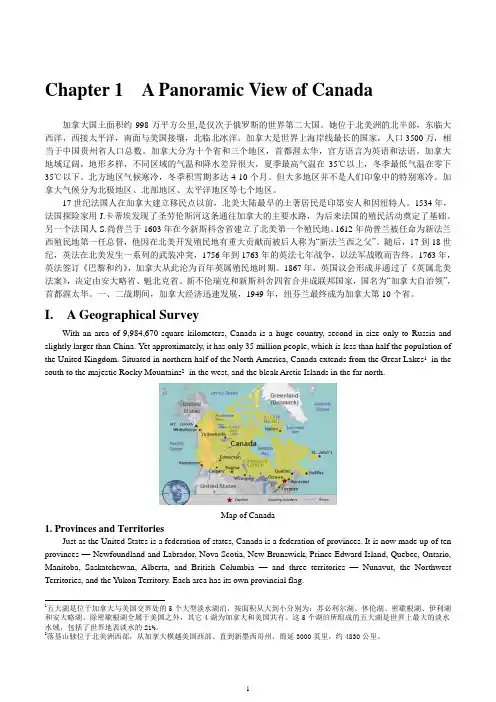
Chapter 1 A Panoramic View of Canada加拿大国土面积约998万平方公里,是仅次于俄罗斯的世界第二大国。
她位于北美洲的北半部,东临大西洋,西接太平洋,南面与美国接壤,北临北冰洋。
加拿大是世界上海岸线最长的国家,人口3500万,相当于中国贵州省人口总数。
加拿大分为十个省和三个地区,首都渥太华,官方语言为英语和法语。
加拿大地域辽阔,地形多样,不同区域的气温和降水差异很大,夏季最高气温在35℃以上,冬季最低气温在零下35℃以下。
北方地区气候寒冷,冬季积雪期多达4-10个月。
但大多地区并不是人们印象中的特别寒冷。
加拿大气候分为北极地区、北部地区、太平洋地区等七个地区。
17世纪法国人在加拿大建立移民点以前,北美大陆最早的土著居民是印第安人和因纽特人。
1534年,法国探险家用J.卡蒂埃发现了圣劳伦斯河这条通往加拿大的主要水路,为后来法国的殖民活动奠定了基础。
另一个法国人S.尚普兰于1603年在今新斯科舍省建立了北美第一个殖民地。
1612年尚普兰被任命为新法兰西殖民地第一任总督,他因在北美开发殖民地有重大贡献而被后人称为“新法兰西之父”。
随后,17到18世纪,英法在北美发生一系列的武装冲突,1756年到1763年的英法七年战争,以法军战败而告终。
1763年,英法签订《巴黎和约》,加拿大从此沦为百年英属殖民地时期。
1867年,英国议会形成并通过了《英属北美法案》,决定由安大略省、魁北克省、新不伦瑞克和新斯科舍四省合并成联邦国家,国名为“加拿大自治领”,首都渥太华。
一、二战期间,加拿大经济迅速发展,1949年,纽芬兰最终成为加拿大第10个省。
I. A Geographical SurveyWith an area of 9,984,670 square kilometers, Canada is a huge country, second in size only to Russia and slightly larger than China. Yet approximately, it has only 35 million people, which is less than half the population of the United Kingdom. Situated in northern half of the North America, Canada extends from the Great Lakes1in the south to the majestic Rocky Mountains2in the west, and the bleak Arctic Islands in the far north.Map of Canada1. Provinces and TerritoriesJust as the United States is a federation of states, Canada is a federation of provinces. It is now made up of ten provinces — Newfoundland and Labrador, Nova Scotia, New Brunswick, Prince Edward Island, Quebec, Ontario, Manitoba, Saskatchewan, Alberta, and British Columbia —and three territories —Nunavut, the Northwest Territories, and the Yukon Territory. Each area has its own provincial flag.1五大湖是位于加拿大与美国交界处的5个大型淡水湖泊,按面积从大到小分别为:苏必利尔湖、休伦湖、密歇根湖、伊利湖和安大略湖。
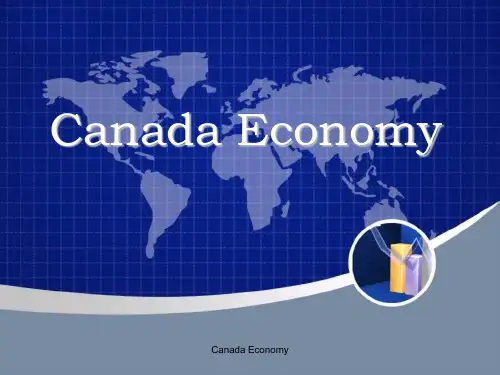

英语作文加拿大的经济发展Canada's Economic Development。
Canada is a country with a strong and diversified economy. Over the years, it has experienced steady growth and has become one of the world's most prosperous nations. The country's economic development can be attributed to several factors, including its natural resources, skilled workforce, and stable political environment.Natural Resources。
Canada is rich in natural resources, which have played a significant role in its economic development. The country is a major producer of oil, natural gas, minerals, and timber, and these resources have contributed significantly to the country's GDP. Canada is also home to some of the world's largest reserves of uranium, nickel, and copper, which are essential to the global economy.Skilled Workforce。
Another factor that has contributed to Canada's economic success is its skilled workforce. The country has a highly educated population, with a strong emphasis on science, technology, engineering, and mathematics (STEM) education. This has helped to create a workforce that is well-equipped to handle the demands of a modern economy. Additionally, Canada has a strong system of vocational training and apprenticeships, which helps to ensure that workers have the skills they need to succeed in their chosen fields.Stable Political Environment。
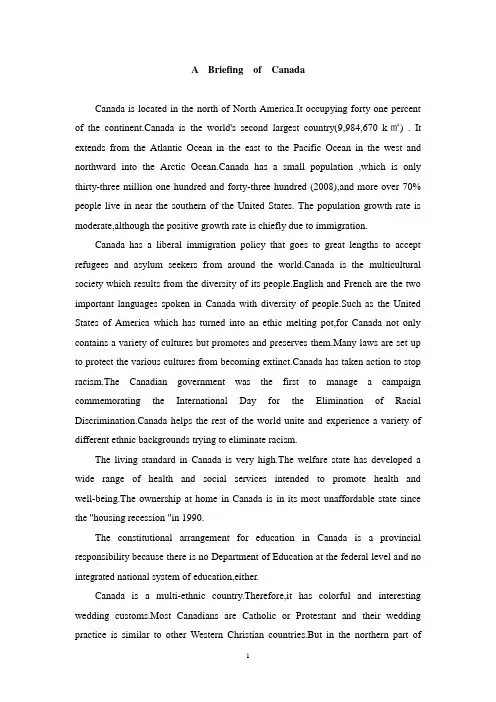
A Briefing of CanadaCanada is located in the north of North America.It occupying forty one percent of the continent.Canada is the world's second largest country(9,984,670 k㎡) . It extends from the Atlantic Ocean in the east to the Pacific Ocean in the west and northward into the Arctic Ocean.Canada has a small population ,which is only thirty-three million one hundred and forty-three hundred (2008),and more over 70% people live in near the southern of the United States. The population growth rate is moderate,although the positive growth rate is chiefly due to immigration.Canada has a liberal immigration policy that goes to great lengths to accept refugees and asylum seekers from around the world.Canada is the multicultural society which results from the diversity of its people.English and French are the two important languages spoken in Canada with diversity of people.Such as the United States of America which has turned into an ethic melting pot,for Canada not only contains a variety of cultures but promotes and preserves them.Many laws are set up to protect the various cultures from becoming extinct.Canada has taken action to stop racism.The Canadian government was the first to manage a campaign commemorating the International Day for the Elimination of Racial Discrimination.Canada helps the rest of the world unite and experience a variety of different ethnic backgrounds trying to eliminate racism.The living standard in Canada is very high.The welfare state has developed a wide range of health and social services intended to promote health and well-being.The ownership at home in Canada is in its most unaffordable state since the "housing recession "in 1990.The constitutional arrangement for education in Canada is a provincial responsibility because there is no Department of Education at the federal level and no integrated national system of education,either.Canada is a multi-ethnic country.Therefore,it has colorful and interesting wedding customs.Most Canadians are Catholic or Protestant and their wedding practice is similar to other Western Christian countries.But in the northern part ofCanada ,the Eskimo area,"bride theft" of the age-old custom has been popular with Eskimos.Canadians love sports.The widespread sports are ice hockey,golf baseball,swimming,basketball and tennis.Universities in Canada have self-contained field and facilities,which can provide for not only the professional teams,but also for students.All above are just the general situation of Canada.Now I want to indicate the relationship between Canada and America.Canada common border with the United States to the south and northwest is the longest in the world. They share the world's longest undefended border, co-operate on military campaigns and exercises, and are each other's largest trading partner.When Canada was under the British colonial rule, its foreign relations were controlled by the British government.Although the Ministry of Foreign Affairs was established in 1909,the foreign policy was still influenced by the United Kingdom.In 2003,the Ministry of Foreign Affairs was separated from the Diplomatic and International Trade Department and functioned as an independent department,which aimed to promote cooperation between Canada and countries.In order to maintain its development and prosperity ,Canada has taken positive attitude in the international and regional affairs.Canada has contributed a lot to promote North-South dialogue,world peace and stability and to assist the poor.In the Canadian value the world order is ruled by law not by the military force.Like the United States, Canada is one of the most religiously divers countries in the world.Canada has no official church ,"God "is mentioned in the preamble to the Canadian Charter of Rights and Freedoms,but no specified.Religious pluralisms an important part of the Canadian worship.Relations between Canada and the United States have spanned more than two centuries. This includes a shared British colonial heritage, warfare during the 1770s and 1812, and the eventual development of one of the most successful international relationships in the modern world. Each is the other's chief economic partner andlarge-scale tourism and migration between the two nations has increased the similarities.The most serious breach in the relationship was the War of 1812, which saw an American invasion of then British North America and counter-invasions from British-Canadian forces. The border was demilitarized after the war and apart from minor raids has remained peaceful. Canada and the United States of America officially established diplomatic relations in 1927,nevertheless two countries have contracts with each other long before.After its independence,the United States of America once attempted to invade the British North America but was defeated by the British Canadian forces.After that the borders between two countries have remained peaceful despite of minor conflict.After the Second World War,the rise of the United States of America in the world makes the Canadian economic,political and diplomatic focus shift from the United Kingdom to the United States.Military collaboration began during World War II and continued throughout the Cold War on both a bilateral basis and through NATO. A high volume of trade and migration between the United States and Canada has generated closer ties, especially after the signing of North American Free Trade Agreement (NAFTA) in 1994.The bilateral relationship is extremely important for both countries.Currently Canada and the United States are the primary trade partners for each other.Canada's economy heavily relies on the United States.They have signed more than one hundred and ninety cooperative agreements involving border,military defense, tariff,labour arbitration,education,environmental protection,fishery and forest protection.Canada also carries out multilateral cooperation with the United States under NATO,APEC,and OAS(Organization of America States).Although two countries have common long-term interests,there are minor conflicts because they are so close to each other.Their repeated trade disputes in fishery and forestry have always existed and Canada's grain export to the United States is charged a dumping duty.The close relationship between Canada and the United States is like brothers.They may quarrel sometimes,but their relationship is tooimportant to be seriously damaged by disagreement over short-term issues.Canada and the United States are currently the world's largest trading partners,share the world's longest unmilitarized border,and have significant interoperability within the defence sphere. Recent difficulties have included repeated trade disputes, environmental concerns, Canadian concern for the future of oil exports, and issues of illegal immigration and the threat of terrorism.The foreign policies of the neighbours have been closely aligned since the Cold War and after. Canada has disagreed with American policies regarding the Vietnam War, the status of Cuba, the Iraq War, Missile Defense, and the War on Terrorism. A serious diplomatic debate is whether the Northwest Passage is in international waters or under Canadian jurisdiction.There are close cultural ties between modern day Canada and the United States, advanced in large part because both nations predominately speak English. There are also historical ties between the respective Francophone populations. Pop culture has depicted and parodied the efforts of both nations to solidify their cultural uniqueness-- primarily by Canada, as its population is roughly one tenth that of the United States'-- to deter international perception that Americans and Canadians are virtually identical. Canada remains Americans' favorite foreign nation according to a recent Gallup poll.Nevertheless there remain Canadian fears of being overwhelmed by its neighbour, which is ten times larger in terms of population and economy. James Tagg reports that Canadian university students have a profound fear that "Canadian culture, and likely Canadian sovereignty, will be overwhelmed."The two economies have increasingly merged since the North American Free Trade Agreement (NAFTA) of 1994.From the above,Canada and the United States of America have the long-time friendly relationship.But Canada just like dances with wolves,and must independent rather than depend on America.References1,《大陆的分界:美国与加拿大的价值与制度》,西摩.马丁.利普森,鲁特埃奇出版公司,1990年(Seymour Martin Lipeset,Continental Divide:the Values and Institutions of the United States and Canada ,Routledge,1990)2,《加拿大社会》,鲁迪.芬威克,美国加拿大研究学会,1989年(Rudy Fenwick,Canada Society,The Association for Canadian Studies in the United States,1989)3,《加拿大文化与现代论》,高鉴国,沈阳辽海出版社,1999年4,《英语国家概况》,隋铭才,高等教育出版社,2009年5,.。
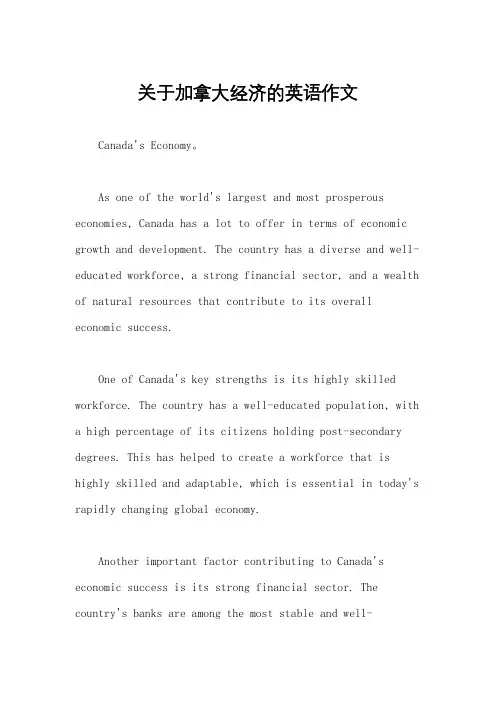
关于加拿大经济的英语作文Canada's Economy。
As one of the world's largest and most prosperous economies, Canada has a lot to offer in terms of economic growth and development. The country has a diverse and well-educated workforce, a strong financial sector, and a wealth of natural resources that contribute to its overall economic success.One of Canada's key strengths is its highly skilled workforce. The country has a well-educated population, with a high percentage of its citizens holding post-secondary degrees. This has helped to create a workforce that is highly skilled and adaptable, which is essential in today's rapidly changing global economy.Another important factor contributing to Canada's economic success is its strong financial sector. The country's banks are among the most stable and well-regulated in the world, which has helped to attract significant foreign investment. This has helped to fuel growth in a range of industries, from technology to natural resources.Canada's natural resources are also a major contributor to its economic success. The country is rich in oil, gas, minerals, and timber, which has helped to create a thriving resource sector. This sector has been a major driver of economic growth, particularly in Western Canada.In recent years, Canada has also been successful in attracting foreign investment in a range of industries, including technology, manufacturing, and finance. This has helped to diversify the country's economy and create new opportunities for growth.Despite these strengths, Canada faces a number of challenges in maintaining its economic success. One of the biggest challenges is the country's aging population, which is putting pressure on the healthcare system and creating a shortage of skilled workers. There is also concern aboutthe country's dependence on resource exports, which can be vulnerable to fluctuations in global commodity prices.To address these challenges, the Canadian government has implemented a range of policies aimed at promoting economic growth and development. These include investments in education and training, as well as initiatives to encourage innovation and entrepreneurship.Overall, Canada's economy is strong and diverse, with a highly skilled workforce, a strong financial sector, and a wealth of natural resources. However, the country will need to continue to adapt and evolve in order to maintain its economic success in the face of changing global conditions.。
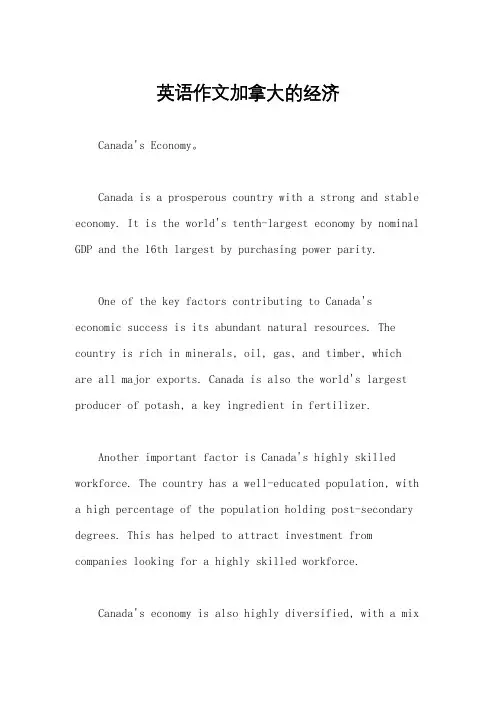
英语作文加拿大的经济Canada's Economy。
Canada is a prosperous country with a strong and stable economy. It is the world's tenth-largest economy by nominal GDP and the 16th largest by purchasing power parity.One of the key factors contributing to Canada's economic success is its abundant natural resources. The country is rich in minerals, oil, gas, and timber, which are all major exports. Canada is also the world's largest producer of potash, a key ingredient in fertilizer.Another important factor is Canada's highly skilled workforce. The country has a well-educated population, with a high percentage of the population holding post-secondary degrees. This has helped to attract investment from companies looking for a highly skilled workforce.Canada's economy is also highly diversified, with a mixof industries including manufacturing, services, and agriculture. The country is home to a number of major corporations, including Bombardier, BlackBerry, and Suncor Energy.In recent years, Canada has been focused on increasing its trade relationships with other countries. The country has signed a number of free trade agreements, including the Comprehensive and Progressive Agreement for Trans-Pacific Partnership (CPTPP) and the Canada-European Union Comprehensive Economic and Trade Agreement (CETA). These agreements have helped to increase Canada's access to international markets and have boosted the country's exports.Despite its strong economy, Canada faces some challenges. One of the biggest challenges is the country's aging population, which is putting pressure on social programs and healthcare. Canada is also facing a shortage of skilled workers in some industries, which could limit the country's economic growth in the future.Overall, Canada's economy is strong and well-positioned for future growth. With its abundant natural resources, skilled workforce, and diversified economy, Canada is a country that is poised for success in the years to come.。
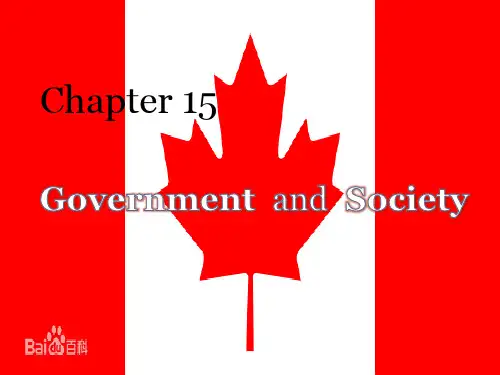
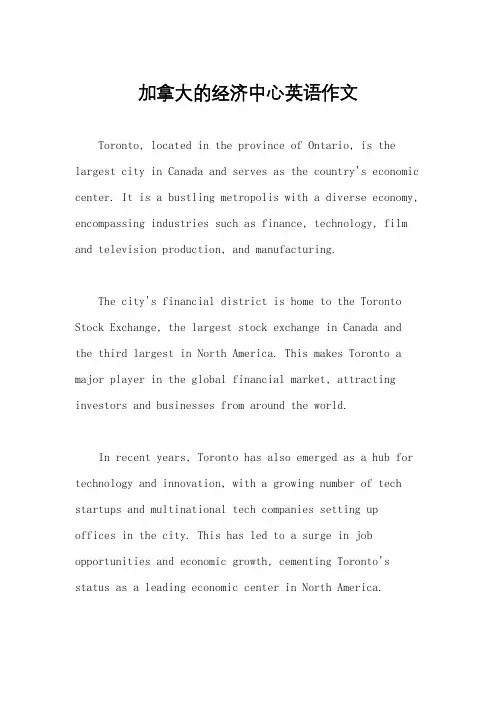
加拿大的经济中心英语作文Toronto, located in the province of Ontario, is the largest city in Canada and serves as the country's economic center. It is a bustling metropolis with a diverse economy, encompassing industries such as finance, technology, film and television production, and manufacturing.The city's financial district is home to the Toronto Stock Exchange, the largest stock exchange in Canada and the third largest in North America. This makes Toronto a major player in the global financial market, attracting investors and businesses from around the world.In recent years, Toronto has also emerged as a hub for technology and innovation, with a growing number of tech startups and multinational tech companies setting upoffices in the city. This has led to a surge in job opportunities and economic growth, cementing Toronto's status as a leading economic center in North America.In addition to finance and technology, Toronto is also a major center for film and television production. Thecity's thriving entertainment industry has contributed significantly to its economy, creating jobs and generating revenue through film and television production, as well as tourism related to the entertainment sector.Furthermore, Toronto has a strong manufacturing sector, producing a wide range of goods such as automobiles, machinery, and consumer products. The city's strategic location and access to transportation networks make it an ideal location for manufacturing and distribution, further bolstering its economic significance.Overall, Toronto's diverse economy and status as a global financial, technological, and entertainment hub make it a key player in Canada's economic landscape. With its strong and resilient economy, the city continues to attract businesses, investors, and talent, driving further growth and prosperity.。
介绍加拿大的英语小作文Canada, located in North America, is a country known for its rich cultural diversity, stunning landscapes, and high quality of life. In this article, we will explore various aspects of Canada, including its history, geography, culture, and economy.First and foremost, Canada is the second-largest country in the world by land area, covering approximately 9.98 million square kilometers. It is bordered by the United States to the south, while the Atlantic Ocean lies to the east, the Pacific Ocean to the west, and the Arctic Ocean to the north. This vast geography offers a wide range of natural wonders, such as the Rocky Mountains, Niagara Falls, and the Great Lakes.Canada has a fascinating history that dates back thousands of years. The indigenous peoples, including the First Nations, Inuit, and Métis, have inhabited the land for centuries. The arrival of European explorers, such as Jacques Cartier and Samuel de Champlain, marked the beginning of colonialism in the 15th and 16th centuries. Eventually, Canada became a self-governing dominion within the British Empire in 1867 and gained full independence in 1982.One of the defining characteristics of Canada is its cultural diversity. With a population of over 37 million people, Canada is a multicultural mosaic, with immigrants from all over the world contributing to its vibrant society. English and French are the official languages, with English being the most widely spoken. However, there are also many other languages spoken throughout the country, reflecting the diverse heritage of its people.In addition to its diverse population, Canada is renowned for its commitment to equality and inclusivity. The country prides itself on its strong social welfare system, universal healthcare, and respect for human rights. Canada consistently ranks high in global indices for quality of life, education, and overall happiness.Economically, Canada is considered one of the wealthiest nations in the world. It has a mixed economy, with key industries including natural resources, manufacturing, andservices. Canada is rich in natural resources, such as oil, gas, minerals, and timber, which contribute significantly to its economy. Moreover, the country has a strong financial sector, with Toronto being one of the world's leading financial centers.Tourism also plays a significant role in Canada's economy. The country attracts millions of visitors each year who come to explore its breathtaking landscapes, national parks, and vibrant cities. Popular tourist destinations include Banff National Park, Vancouver, Toronto, and Montreal.In conclusion, Canada is a country of immense beauty, cultural diversity, and economic prosperity. Its vast geography, rich history, and inclusive society make it an attractive destination for people from all walks of life. Whether it's exploring the stunning natural landscapes or experiencing the multicultural cities, Canada offers something for everyone.。
Economy of CanadaIntroduction•Canada is one of the world's wealthiest nations,and the majority of its citizens enjoy a high quality of life by world standards.Natural Resources•vast forest•fresh water•oil•gas•the world's richest mineral deposits •Canada is renowned for the wealth of it's natural resources.Main Industry•The service sector in Canada is the largest industry,employing some three quarters of Canadians and producing about two thirds of its CDP.•Manufacturing and fishing are the most important economic activities in Canada.Pattern of Economy •Canada is a free market economy and is highly intergrated into the global economy.•Due to its small population and limited domestic market,Canada is dependent on international trade,especially trade with the United States.Trading Partners •Canada is the ninth largest trading nation in the world,with theU.S.,Japan and Britain being its largest trading partners.Development of Exporting•In the early colonial period,the leading Canadian export commodities were fish and furs.•During the 19th century, timber became the staple export item.•In the early 20th century,with the improvement of railway lines,wheat became the chief export item.•Now,the exploration of minerals enables the manufacturing industries to produce more than half of Canada's exports.Solid Economic Prospects •Since the recession of the early 1990s,the Canadian economy has grown more rapidly than that of most other developed countries,resulting from several factors,including low inflation,low interest rats,and a low Canadian dollar,all of which helped exports grow.Today,with its abundant natural resources,skilled labor force,and modern capital plant,Canada enjoys solid economic prospects.。